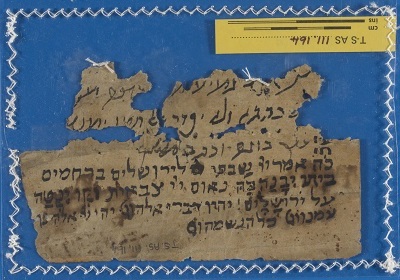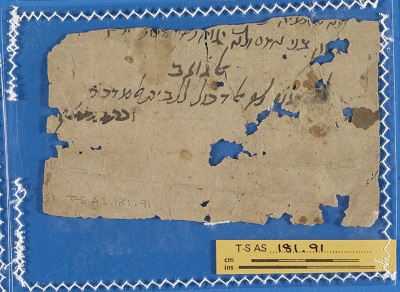This is the first in what will be a regular feature on the website. A fragment that has provoked interest in the Unit in the last month will be displayed together with a brief explanation as to why it deserves attention.
Day in, day out, Unit researchers are working on cataloguing and describing the Taylor-Schechter Collection; hundreds and thousands of manuscripts are examined each month. Just occasionally work stops and colleagues call each other over to take a look at an unusual, unexpected or particularly interesting fragment. In itself the small piece of paper or vellum may not be that significant — when viewed in the wider context of the tens of thousands of pieces in the Collection — and it may ultimately get no more than a brief mention in one of the Genizah Series catalogues, but it has provoked our interest for a moment and so earned a place here.
Flouting the rules from the beginning, I present here not one but two interesting fragments. Moses Maimonides, the Rambam, has a particularly distinctive handwriting and I spotted these two examples of it while surveying manuscripts for the Hebrew documents project. Both contain previously unknown responsa (formal answers to halakhic queries) by the Rambam and signed, as was usual for him, simply with 'Moses'. The Rambam's responsa were published and promulgated after his death. A number of autograph responsa have been discovered in the Genizah and none of them are found in the posthumous collections of his responsa. The same applies with these two new discoveries, as far as their fragmentary condition allows me to tell this.
The manuscripts contain the original question, to which the Rambam has appended his reply, using the same piece of paper (this was his usual practice: it helped to keep question and answer together and enabled him to reply quickly and briefly). Very little of either question is preserved, but Maimonides' entire reply is extant in the second fragment. We can only guess, however, the nature of the question that required the short and uncompromising answer 'He is not allowed to enter the aforementioned house'!
Two New Responsa of Moses Maimonides
T-S AS 111.164
Paper; 7.4 x 12.7; 3 lines (Rambam text) + 4 lines of liturgical text (+ 1 in the margin) (recto); 10 lines (verso); torn across the top and at the sides
Only the last three lines of the reply, including the signature, are preserved.
1 [...] אן [ ]קל גמיע מ[ ]צה מן [...]
2 [ו]שבההא ולא יקדר אלתמן ימנע[...]
3 דׁלך בוגׁה וכתב משה
Translation
1 that [ ] all of [ ] from […]
2 and the like. And he may not assess the value; he should prevent […]
3 this at all. Moses wrote this.
Notes:
The rest of this side of the leaf contains a liturgical text in Hebrew, in a different hand, the beginning of which is overleaf (entitled תפלה); it postdates the Rambam responsum.
T-S AS 181.91
Paper; 7.8 x 12.5; 5 lines (recto); various lines (verso); torn across the top
1 לא אסמיה [...]
2 [ ]ון בני אדם ולא יגוז לה אלדכול [להונ]א
3 אלגׁואב
4 ל[א י]גׁוז לה אלדכול ללבית אלמדכור
5 וכתב משה
Translation
1 I won’t name him […]
2 [ ] people and he is not allowed to enter [there]
3 The answer:
4 He is not allowed to enter the aforementioned house.
5 Moses wrote this.
Verso contains Arabic script, including jottings and writing exercises.
Readers are invited to send comments to genizah@lib.cam.ac.uk. The Taylor-Schechter Genizah Research Unit is not under any obligation to acknowledge or to publish comments.
Comments on Two New Responsa of Moses Maimonides
from Professor Mordechai A. Friedman, Tel Aviv University
Congratulations to Dr. Ben Outhwaite on this exciting new feature of the CUL Taylor-Schechter Genizah Research Unit website: “Fragment of the Month.”
The first items, two scraps of previously unknown responsa of Maimonides, are a particularly valuable contribution, as the interest in the master’s writings is universal and timeless. Even the smallest scrap can contain unexpected information about his work and the Geniza society. Dr. Outhwaite deserves special thanks for disseminating these finds with excellent-quality digital images. These immediately make the new find accessible to scholars worldwide and enable them to check the decipherment and translations and comment. In this spirit, I share the following notes.
The beginning of the first piece, T-S AS 111.164 is too fragmentary to decipher in a useful fashion at the present. But the main clause in lines 2–3, should be read, with a slight correction of the decipherment:
... ולא יקדר אלחמו ימנע
דלך בוגה
and rather than: “And he may not assess the value; he should prevent […] this at all,”
this should be translated: “And the father-in-law cannot prevent this at all.”
From the fragment, we cannot know what the father-in-law wanted to prevent, but the Geniza contains documents that show that a young bride’s parents tried to extend their influence over her, even though she was no longer in their jurisdiction. Such a case is found in Maimonides’ published responsa, Joshua Blau’s edition, 2:347–48, no. 191. Of course, the responsum could be concerning the groom’s father and have a completely different background.
The second item, T-S AS 181.191, as already noted, contains Maimonides’ complete, one-line reply. In translation: “He is not allowed to enter the aforementioned house.” At first blush, the nature of the question, from which only parts of two lines remain, is something about which “we can only guess.” However, when zooming in on the image, a slight correction of the decipherment produces the following reading and restoration:
ולא אסמיה [ד]לך (?) [או בנדרים הלך אחר]
ל[ש]ון בני אדם ולא יגוז לה אלדכול [...]
and rather than: “I won’t name him […] people and he is not allowed to enter [there],”
this should be translated: “and I do not call it that (?). [Or: ‘in vows follow] common people‘s speech,‘ and he is not allowed,” etc.
The restored quote appears in the Babylonian Talmud, tractate Nedarim 30b and parallels. The question could concern an actual case or be theoretical. The doubt is whether one who made a vow not to enter a certain area can say he didn't mean the ‘house’ when he undertook the prohibition, because he calls that by a different word. Or do we say that in vows, the commonly accepted terminology is binding. Maimonides rules according to the second alternative, following the Talmudic quote. This is also his codified ruling in Mishne Torah, Laws of Nedarim 9:1. See 9:15-16, for vows not to enter houses.
Cite this article
(2007). Two New Responsa of Moses Maimonides. [Genizah Research Unit, Fragment of the Month, April 2007]. https://doi.org/10.17863/CAM.34048
If you enjoyed this Fragment of the Month, you can find others here.
Contact us: genizah@lib.cam.ac.uk
The zoomable images are produced using Cloud Zoom, a jQueryimage zoom plugin:
Cloud Zoom, Copyright (c) 2010, R Cecco, www.professorcloud.com
Licensed under the MIT License


